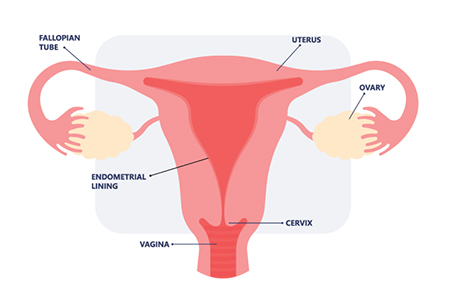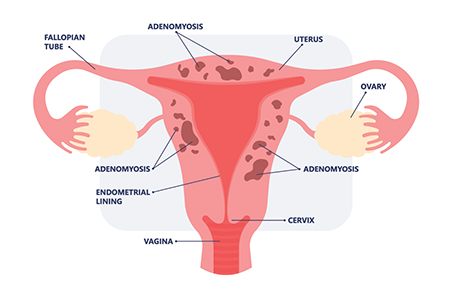Adenomyosis is often associated with endometriosis, but there are unique differences. Find out how it compares with endometriosis on key things such as symptoms, treatment and diagnosis.
Similarity #1: Adenomyosis involves endometrial-like tissue
The tissue that lines the inside of the uterus is the endometrium. In adenomyosis, tissue similar to this lining starts to grow in the muscle of the uterus. If that sounds familiar, you’d be right! In endometriosis, this endometrial-like tissue grows outside of the uterus.
In essence, endometriosis is always located outside of the uterus while adenomyosis occurs in the muscle of the uterus. Adenomyosis can also cause the uterus to enlarge.

Uterus with no adenomyosis

Uterus with adenomyosis
Similarity #2: Adenomyosis and endometriosis share symptoms and people commonly have both conditions
The symptoms of adenomyosis are period pain, pelvic pain, pain before and after your period, and heavy menstrual bleeding. These symptoms overlap with endometriosis. Other symptoms of endometriosis include infertility, ovulation pain, bloating, diarrhoea and constipation.
Painful sex (dyspareunia) is a common endometriosis symptom and is sometimes present in adenomyosis.
Adenomyosis and endometriosis can greatly impact quality of life, with pain that stops you from participating in work, study and everyday activities. Both conditions can have an impact on fertility.
It’s very common for people to have adenomyosis and endometriosis together. However, the exact percentage of people with both is unclear and depends on further study. Best estimates predict approximately a third of patients with endometriosis also have adenomyosis.
Similarity #3: Medical imaging is a tool to investigate both adenomyosis and endometriosis
Imaging can help lead to a diagnosis in both conditions. The pathway to diagnosis is similar and may involve a pelvic exam, ultrasound and/or MRI.
The MOST accurate way to diagnose each differs, with endometriosis diagnosed most accurately at laparoscopy, and adenomyosis most accurately diagnosed by examining excised tissue under the microscope.
Moderate to severe forms of both can be seen on a high-quality pelvic ultrasound.
Similarity #4: Gynaecologists treat adenomyosis and endometriosis
A gynaecologist is a specialist doctor who may diagnose, manage and treat adenomyosis and endometriosis. Not all gynaecologists work in this area, so finding a specialist suited to your needs is important. You can speak to the Endometriosis Nurse Coordinator at the Julia Argyrou Endometriosis Centre at Epworth to help you decide on a specialist with experience in adenomyosis.
A multidisciplinary approach, where different kinds of health professionals work together, is helpful for both conditions. Your team may include nurses, physiotherapists, pain specialists, psychologists, dietitians and occupational therapists.
Similarity #5: They share treatment options, although adenomyosis has a cure
Hysterectomy, or surgical removal of the uterus, cures adenomyosis. This means it doesn’t return afterwards. There is no known cure for endometriosis – yet.
Other options such as hormone therapy and pain management aim to help with symptom relief for adenomyosis. You'll see these used in endometriosis too, as both conditions are stimulated by the hormone oestrogen.
Read more: Adenomyosis - in detail
There is support – our dedicated Endometriosis Nurse Coordinator can help you navigate adenomyosis and endometriosis. The Julia Argyrou Endometriosis Centre at Epworth has a network of specialists ready to work with you to improve your quality of life.
27 April 2022

